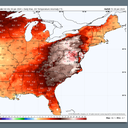Washington hits 80 degrees as January thaw envelops North America

A January thaw for the record books is firmly established across much of North America, with Washington, D.C., setting an all-time January high temperature record of 80°F Friday, as similar milestones fell elsewhere.
Why it matters: The record warmth is by far the earliest 80-degree temperature D.C. had ever seen, coming weeks before the previous 80-degree high and just one week after snow blanketed the nation's capital.
- In an average year, the city doesn't see 80-degree temperatures until around March 28, per the Washington Post's Capital Weather Gang.
- In many locations in the U.S., the winter is the fastest warming season, with record-breaking thaws happening more frequently.
By the numbers: Reagan National Airport, the observing site for the city, reached 80 degrees around 2pm ET, breaking the previous monthly record of 79°F, set on Jan. 26, 1950.
- The previous earliest 80-degree temperature in Washington came on Feb. 21 in 2018.
- Washington's Dulles International Airport had peaked at 79°F around 2 pm on Friday.
- Charleston, S.C. had reached 83°F Friday afternoon, tying the city's monthly record for January.
- Wilmington, N.C. beat its all-time January record as well, with a preliminary high of 83°F Friday.
The big picture: Cold air has been in short supply this winter in parts of the country, particularly the Mid-Atlantic and Southeast. A cold spell during early to mid-January has given way to a thaw projected to last into February, as a relatively mild Pacific flow of air dominates weather patterns.
- The record warmth on Friday resulted from a low pressure area moving to the west of the Appalachians, as a warm front pushed north, past Washington and Baltimore.
- But zooming out, much of North America is experiencing milder-than-average conditions right now, with temperatures of 20-35°F above average in Canada, and pulses of mild air pushing across the U.S.
Between the lines: According to a recent analysis from Climate Central, cold spells are moderating quickly across the U.S. due to human-caused global warming.
- Since 1970, the coldest day of the year has warmed by an average of 7°F across 242 locations the climate research and communications group analyzed.
- The areas that have seen coldest days moderate the most are the Ohio Valley and Northwest.
- Researchers also found that while extreme cold events are still occurring in a warming world, they are becoming less frequent and milder nationwide.